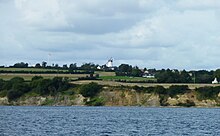Düppeler mill
The Düppeler Mill (Danish Dybbøl Mølle ) is a Dutch windmill built in 1744 and rebuilt several times after repeated destruction at the Düppeler Schanzen near the Danish town of Sønderborg (German: Sonderborg ). Because of its strategic importance in two wars and its role in the eventful history of North Schleswig , it is considered the Danish national symbol . It was in operation until 1990 and has been used as a museum since 1995 , in which the history and technology of the mill are documented and objects from the wars from 1848 to 1851 and from 1864 are shown.
history
Düppel's first mill was built from wood in 1744 . After it burned down as a result of a lightning strike in 1800 , it was rebuilt for the first time. During the Schleswig-Holstein War from 1848 to 1851 and the German-Danish War of 1864, the mill was destroyed in April 1849 and April 1864 because of its location in the center of the fighting, but was rebuilt after both wars. In the war of 1864, the Danish military sent messages to the troops stationed on Alsen Island through the position of the mill wings .
It burned down in 1935 due to a short circuit . The fifth mill building, built in 1936 from brick , was the motif of a series of Danish welfare stamps in 1937 . The mill was in operation until 1990 and has been used as a museum since 1995 . In 2009 the mill was completely renovated for 5.5 million Danish kroner with funds from AP Møller og Hustru Chastine Mc-Kinney Møllers Fund , the private foundation of the Danish shipowner Mærsk Mc-Kinney Møller and his wife.
Museum and memorial
In the exhibition of the museum, except the Düppeler mill and the associated grain storage includes the history and technology in several rooms through drawings and pictures of the mill as well as its importance as a Danish national symbol illustrated and uniforms , weapons and other items from the wars of 1848 until 1851 as well as from 1864. The museum is visited by around 50,000 people annually. The entire complex of the Düppeler Schanzen, to which the mill belongs, is a national memorial site protected by state purchases and a development ban.
In the vicinity of the mill there are also several memorials to the fallen in the war of 1864 and with the history center Dybbøl Banke a history center in which the prehistory, the course and the effects of the war are documented, as well as a museum on the history of South Jutland and in Sønderborg Castle North Schleswig . The Gendarmstien , an approximately 74-kilometer hiking trail that follows the former path used by the Danish border gendarmerie to monitor the state border, also runs near the mill.
literature
- Inge Adriansen: The Düppeler Mühle: Monument & Museum. Published by the Museum Schloss Sonderburg, Sonderburg 1997, ISBN 87-87153-31-9
- Inge Adriansen: National symboler i Det Danske Rige 1830-2000. Second volume. Museum Tusculanums Forlag, Copenhagen 2003, ISBN 87-7289-794-5 , pp. 245-276
Web links
- Velkommen til Dybbøl Mølle website with information about the mill and the museum (Danish)
Coordinates: 54 ° 54 ′ 25 " N , 9 ° 45 ′ 28.7" E


